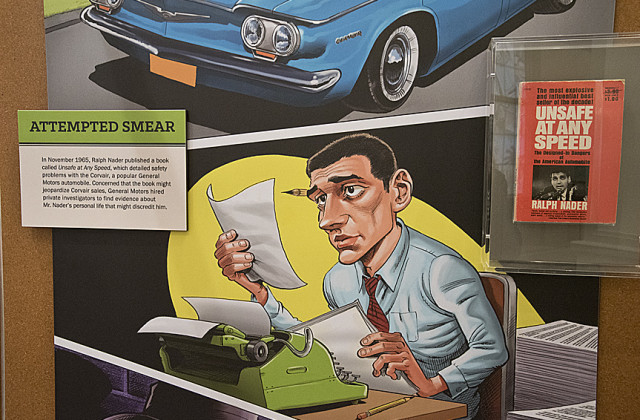Museum of American Tort Law in Winsted Educates and Entertains
Grand Spring Reopening Planned for April 2
By Ruth Melville

A Chevy Corvair, made infamous by Ralph Nader, is one of th interesting and informative displays at the American Museum of Tort Law in Winsted. Photograph by Bruce Frisch
Say “tort law” to most people, and their eyes glaze over with boredom, but a new museum in Winsted is determined to change your mind. Far from being a dusty or arcane subject, tort law—which concerns the right of the average citizen to sue for compensation—is a crucial piece of American democracy.
The American Museum of Tort Law, the only museum of law in the country, opened last fall in the former Winsted Savings Bank on Main Street. It is the brainchild of Ralph Nader, perhaps the preeminent advocate of tort law in the United States, and a Winsted native. Since 1998, Nader had wanted to open a museum to educate people about the importance of tort law in ensuring “that no one—no matter how big or how rich—is above the law.”
Briefly put, tort law is the law of wrongful injury. It allows people to go to court for compensation when they feel they have been injured by the wrongful acts of others, whether people or corporations. The museum wants visitors to come away with an appreciation of the importance of tort law “in protecting people’s personal freedom, health and safety.”
To help make its potentially dry subject more visually interesting, the museum turned to a group of artists, illustrators and cartoonists to draw the friezes and colorful panels that illustrate the cases and principles presented. The lively drawings have pop art flair. Interactive screens, artifacts and mixed media add to the visual appeal and instructional content. To encourage debate, printed panels offer “Questions for Thought” about issues raised by the exhibits.
The museum is divided into three major rooms or galleries. The entrance hall presents a mural showing timeline of the history of American tort law, which has its roots in English common law. Much of the 20th century was good for tort law. The first comprehensive workers compensation law passed in 1911, and from the 1950’s through the 1970’s, the law expanded to hold businesses more accountable for physical, economic and emotional damages. More recently, though, there have been successful attempts to limit liability and cap or reduce settlements. Nader calls these setbacks “tort deform.”
The next gallery is labeled “Cases That Made a Difference,” and Sara Nowak, assistant director of the museum, says room is a kind of “Torts 101.” Joseph Page, professor emeritus at Georgetown University’s School of Law, has selected the important precedent-setting cases. These cases, some dating back to the 1800’s, are still relevant. A case from 1873, for example, introduced the concept of an “attractive nuisance.”
The largest room is devoted to some of the most notable tort cases in the last century. Several remain well remembered today: cases against the tobacco and asbestos industries; the Ford Pinto case, during which internal documents revealed that the company had known that in certain circumstances the gas tanks could explode, but decided not to spend the extra money to make the car safer; and the McDonald’s hot coffee case, when a 79-year-old woman sued after she was scalded by her coffee.
This last case was widely ridiculed in the press at the time: surely everyone knows that coffee is hot! The wall plaques, however, point out the often-unreported facts that McDonald’s was superheating its coffee to 180-90 degrees (well above industry standard), and that there had been 700 previous reports of burns that the company had ignored. Also, contrary to public reports, the injured woman was not trying to enrich herself by suing a major company. Originally, all she requested was McDonald’s help in paying her hospital expenses.
A major cause for Nader throughout his career as a consumer rights activist has been automobile safety. It was the topic of his 1965 book “Unsafe at Any Speed,” which first brought him to national attention. It is fitting that the centerpiece of the final gallery, and the largest artifact in the museum, is a car—a bright red 1963 Chevy Corvair. In his book Nader criticized the Corvair, and its manufacturer, General Motors (GM), for structural flaws that had led to a series of accidents. When GM responded by hiring private detectives to try to discredit him, Nader sued the company for “invasion of privacy” and won a $425,000 settlement and a public apology.
Since its opening last September, the American Museum of Tort Law has attracted visitors of all kinds, including senior groups, students (especially law students), tourists and, interestingly enough, car enthusiasts. The museum is appropriate, informative and entertaining for visitors from high school age on.
The museum has been closed for the winter, but the grand reopening is scheduled for April 2. Speaking at the opening ceremony will be Mitchell Garabedian, the Boston attorney recently portrayed by Stanley Tucci in the movie “Spotlight” (which won the Academy Award for Best Picture); Jan Schlichtmann, the attorney in the well-known Woburn, Mass., case about contaminated drinking water, played by John Travolta in the movie “A Civil Action”; and Ralph Nader.
The museum is open from 10:30 a.m. to 5 p.m., Wednesday to Monday, and there is an admission charge of $7 for adults and $5 for students and seniors. For more information—about the museum or the reopening ceremony—visit www.tortmuseum.org or call 860-379-0505.

